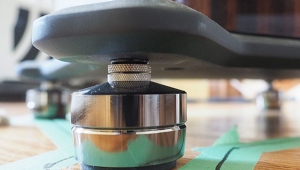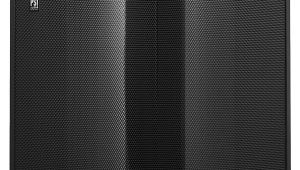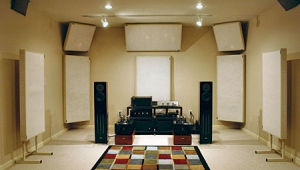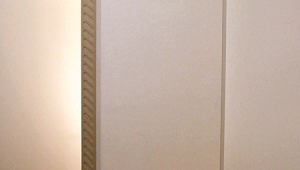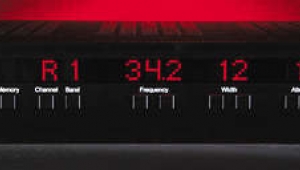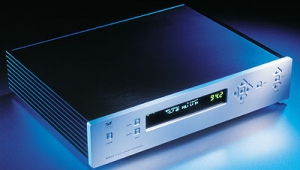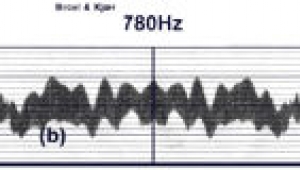| Columns Retired Columns & Blogs |
Rives Audio PARC 3-Band Parametric Equalizer Page 2
Easy as PARC
The PARC is a three-band, two-channel parametric equalizer whose front panel clearly reveals what it is and what it does. Above each control is an indicator LED or a numeric readout of its status. Beginning on the left, the first button, Display, toggles the display of the numeric readouts without affecting any other functions; you don't need that bright, bold display when you've finally set the device to your liking. Next are Save and Memory, which permit you to store and recall settings in any of three nonvolatile memories.
Footnote 2: Since the PARC can only attenuate, not amplify, it can deal only with resonant peaks, not resonant nulls. Rives argues that this is a conservative and parsimonious approach that is less likely to lead to garish abuse than would ill-applied amplification. It can also be argued that the resonant modes will still store energy, even with attenuation, smearing the transient performance of the system, and that a comparable gain-correction of nulls is likely to have less of an effect on transient performance. Thus, aside from keeping us from abusing the PARC or exceeding power limits for the amp or speaker, I can think of no theoretical justification for not offering some null correction. Richard Bird tells me that the PARC hardware is capable of applying gain, but that the current software does not. They are considering a software modification to permit a small amount (up to 6dB) of gain.—Kalman Rubinson
The PARC is a three-band, two-channel parametric equalizer whose front panel clearly reveals what it is and what it does. Above each control is an indicator LED or a numeric readout of its status. Beginning on the left, the first button, Display, toggles the display of the numeric readouts without affecting any other functions; you don't need that bright, bold display when you've finally set the device to your liking. Next are Save and Memory, which permit you to store and recall settings in any of three nonvolatile memories.
The Channel button selects whether the left or right channel is being adjusted, and Band selects which of the three available bands is being set. The next six buttons determine how that band is configured: The Frequency Up/Down buttons select a center frequency, the Width Up/Down buttons select the Q factor or width of the attenuated band centered on that frequency, and the Attenuation Up/Down buttons select the magnitude of the attenuation. (Unusually, only attenuation is offered, not boost.) Finally, the very useful Bypass button permits you to A/B the PARC's EQ'd and flat responses.
The rear panel is fairly symmetrical, centered around an IEC power socket, power switch, and fuse panel. Above those is an RS-232 comm port for computer communication, and a six-pin XLR for expansion of the two-channel PARC with a four-channel PARC-Plus to make a six-channel system. On either side of the central facilities are the left and right input/output facilities. Each of these consists of XLR and RCA inputs and outputs and an XLR/RCA toggle switch to select between the inputs. Both XLR and RCA outputs are always active when the PARC is powered up, but with power off, the audio signals will pass through from RCA to RCA and from XLR to XLR regardless of toggle setting.
In order to use the PARC, one could, of course, measure the room dimensions and calculate all the fundamental frequencies and overtones...but that way lies madness. You can model your room and speakers with CARA, or try one of several online calculators that are useful for planning. However, as the speakers' effective room interaction is greatly influenced by placement and by everything else in the room, I thought direct response measurement would be definitely better for this review.
One approach is to use computer analysis of calibrated pulses, such as ETF. PARC has a similar associated component, the Bass And Room Evaluator (BARE), which will do this quickly and efficiently, but it's still in beta stage and requires a PC, a microphone, and another $100. However, Rives supplies a simple alternative with the PARC: a test CD with tones for a calibrated meter, and another set of tones corrected for use with the ubiquitous RadioShack SPL meter. The latter approach is tedious, BARE (or ETF) being much easier, but I did get comparable results from the CD and from BARE. Such convenience, and the ease of re-measuring the response after correction to confirm the settings, make me hope that Rives will decide to bundle the finished BARE into the PARC package.
After measuring the response of each speaker, Rives advises finding the room's three major resonant peaks in the response below 350Hz. The PARC manual states that "the purpose is to reduce the frequencies caused by room excitation" (footnote 2). Following the manual's clear guidance, you calculate and enter the magnitude and width of each peak into the attenuation and Q settings of the parametric filter. Simple arithmetic, really, and a calculator is a useful luxury. Rives suggests entering the flattest response into Memory 1 and using the other memories for "tailored" responses. Other uses for the additional memories might be for particular sources (nah, none of us have rumbly turntables), alternative speakers, or alternative speaker and/or listener positions.
PARC Place
When Richard Bird delivered the PARC, I had just restored my Revel Ultima Studio loudspeakers to my main system. Though somewhere in the vicinity of their old sweet spots, they were not carefully positioned. They imaged well and had good midrange presence, but were a little lumpy in the bass—which, of course, made them prime candidates for the PARC treatment. The PARC was wired into the system between the Sonic Frontiers Line-3 preamplifier and Power-3 power amps with a short length of AudioQuest Python Balanced interconnect to supplement the normal long run.
The BARE facts confirmed the lumpy bass in both channels (figs.1 and 3). Note that the frequency scale of these graphs is linear, not the logarithmic scale usually used in Stereophile, so the peak at 32.7Hz in the left channel (fig.1) looks much narrower relative to the others than it otherwise would. As you can see from the chart below, its Q is actually lower than the peak at 350Hz but slightly higher than that at 134Hz. Similarly, the three peaks in the right channel (fig.3) appear, in this linear scale, to be similar but have substantially different Qs. Remember, Q= (center frequency) / (peak width at -3dB).
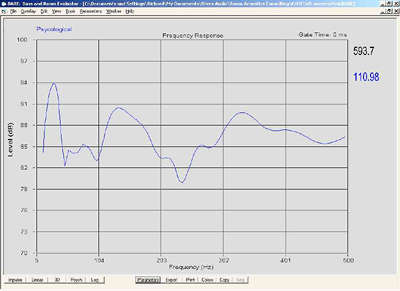
Fig.1 Rives PARC, uncorrected response of left channel from BARE. Peaks can be seen at 32.7Hz, 134Hz, and 340Hz.
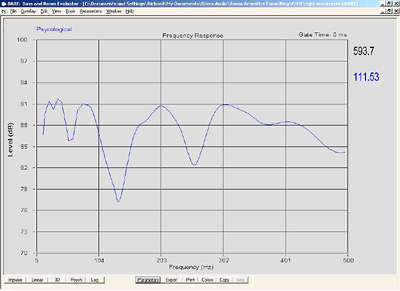
Fig.3 Rives PARC, uncorrected response of right channel from BARE. Two peaks can be seen flanking 35.3Hz and single peaks at 84.5Hz, 211Hz, and 302Hz.
Footnote 2: Since the PARC can only attenuate, not amplify, it can deal only with resonant peaks, not resonant nulls. Rives argues that this is a conservative and parsimonious approach that is less likely to lead to garish abuse than would ill-applied amplification. It can also be argued that the resonant modes will still store energy, even with attenuation, smearing the transient performance of the system, and that a comparable gain-correction of nulls is likely to have less of an effect on transient performance. Thus, aside from keeping us from abusing the PARC or exceeding power limits for the amp or speaker, I can think of no theoretical justification for not offering some null correction. Richard Bird tells me that the PARC hardware is capable of applying gain, but that the current software does not. They are considering a software modification to permit a small amount (up to 6dB) of gain.—Kalman Rubinson
- Log in or register to post comments
